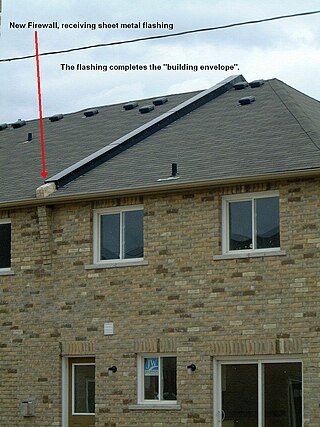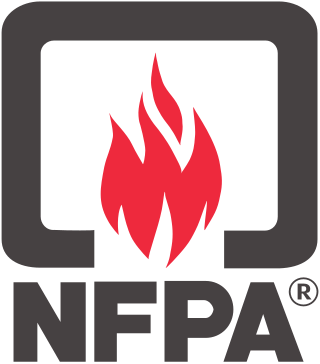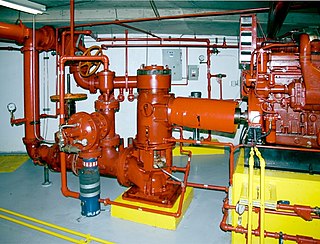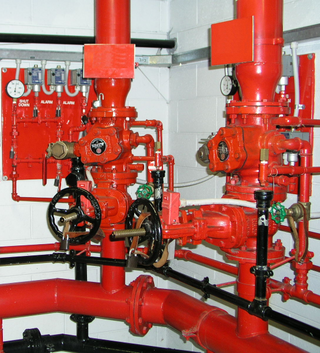Related Research Articles

A firewall is a fire-resistant barrier used to prevent the spread of fire. Firewalls are built between or through buildings, structures, or electrical substation transformers, or within an aircraft or vehicle.

The Station nightclub fire occurred on the evening of February 20, 2003, at The Station, a nightclub and hard rock music venue in West Warwick, Rhode Island, United States, killing 100 people and injuring 230. During a concert by the rock band Great White, a pyrotechnic display ignited flammable acoustic foam in the walls and ceilings surrounding the stage. Within six minutes, the entire building was engulfed in flames. The fire was the deadliest fireworks accident in U.S. history and the fourth-deadliest nightclub fire in U.S. history. It was also the second-deadliest nightclub fire in New England, behind the 1942 Cocoanut Grove fire.

A fire sprinkler system is an active fire protection method, consisting of a water supply system providing adequate pressure and flowrate to a water distribution piping system, to which fire sprinklers are connected. Although initially used only in factories and large commercial buildings, systems for homes and small buildings are now available at a cost-effective price.

The National Electrical Code (NEC), or NFPA 70, is a regionally adoptable standard for the safe installation of electrical wiring and equipment in the United States. It is part of the National Fire Code series published by the National Fire Protection Association (NFPA), a private trade association. Despite the use of the term "national," it is not a federal law. It is typically adopted by states and municipalities in an effort to standardize their enforcement of safe electrical practices. In some cases, the NEC is amended, altered and may even be rejected in lieu of regional regulations as voted on by local governing bodies.

The National Fire Protection Association (NFPA) is a U.S.-based international nonprofit organization devoted to eliminating death, injury, property, and economic loss due to fire, electrical, and related hazards. As of 2023, the NFPA claims to have 50,000 members and 9,000 volunteers working with the organization through its 250 technical committees.

Fire safety is the set of practices intended to reduce destruction caused by fire. Fire safety measures include those that are intended to prevent the ignition of an uncontrolled fire and those that are used to limit the spread and impact of a fire.

A fire door is a door with a fire-resistance rating used as part of a passive fire protection system to reduce the spread of fire and smoke between separate compartments of a structure and to enable safe egress from a building or structure or ship. In North American building codes, it, along with fire dampers, is often referred to as a closure, which can be derated compared against the fire separation that contains it, provided that this barrier is not a firewall or an occupancy separation. In Europe national standards for fire doors have been harmonised with the introduction of the new standard EN 16034, which refers to fire doors as fire-resisting door sets. Starting September 2016, a common CE marking procedure was available abolishing trade barriers within the European Union for these types of products. In the UK, it is Part B of the Building Regulations that sets out the minimum requirements for the fire protection that must be implemented in all dwellings this includes the use of fire doors. All fire doors must be installed with the appropriate fire resistant fittings, such as the frame and door hardware, for it to fully comply with any fire regulations.

NFPA 1901, the Standard for Automotive Fire Apparatus, is published by the National Fire Protection Association to outline the standard for firefighting apparatus. The listing sets minimum standards for mechanical, cosmetic, lighting, and all equipment to be included with fire apparatus to be standards compliant in the United States. The current version of 1901 is the 2016 edition.
The International Code Council (ICC) is a nonprofit standards organization that creates the International Building Code (IBC), a model building code, as well as the International Residential Code (IRC), and other model codes. The IBC has been adopted for use as a base code standard by most jurisdictions in the United States.
NFPA 70E(Standard for Electrical Safety in the Workplace) is a standard of the National Fire Protection Association (NFPA). The document covers electrical safety requirements for employees. The NFPA is best known for publishing the National Electrical Code.

A fire pump usually refers to a pressure-increasing component of the water supply for fixed-place fire suppression systems such as fire sprinklers, standpipes, and foam systems. Fire pumps are also a critical component integrated into fire trucks and fire boats, and serve a similar purpose boosting water supplies for firefighting hose operations.

A fire alarm system is a building system designed to detect, alert occupants, and alert emergency forces of the presence of fire, smoke, carbon monoxide, or other fire-related emergencies. Fire alarm systems are required in most commercial buildings. They may include smoke detectors, heat detectors, and manual fire alarm activation devices. All components of a fire alarm system are connected to a fire alarm control panel. Fire alarm control panels are usually found in an electrical or panel room. Fire alarm systems generally use visual and audio signalization to warn the occupants of the building. Some fire alarm systems may also disable elevators, which are unsafe to use during a fire under most circumstances.
Within the context of building construction and building codes, occupancy is the use of a building for the shelter or support of persons, animals or property. A closely related meaning is the number of units in such a building that are rented, leased, or otherwise in use. Lack of occupancy, in this sense, is known as vacancy.
Heat and smoke vents are installed in buildings as an active fire protection measure. They are openings in the roof which are intended to vent the heat and smoke developed by a fire inside the building by the action of buoyancy, such that they are known as "gravity vents".

A combustible material is a material that can burn in air under certain conditions. A material is flammable if it ignites easily at ambient temperatures. In other words, a combustible material ignites with some effort and a flammable material catches fire immediately on exposure to flame.
The NFPA 72 is a standard published by the National Fire Protection Association every 3 years for installation of fire alarm systems and emergency communication systems in the United States.

Sprinkler fitting is an occupation consisting of the installing, testing, inspecting, and certifying of automatic fire suppression systems in all types of structures. Sprinkler systems installed by sprinkler fitters can include the underground supply as well as integrated overhead piping systems and standpipes. The fire suppression piping may contain water, air, antifreeze, gas or chemicals as in a hood system, or a mixture producing fire retardant foam.

A lightning rod or lightning conductor is a metal rod mounted on a structure and intended to protect the structure from a lightning strike. If lightning hits the structure, it is most likely to strike the rod and be conducted to ground through a wire, rather than passing through the structure, where it could start a fire or cause electrocution. Lightning rods are also called finials, air terminals, or strike termination devices.
The Fire Sprinkler Incentive Act (FSIA) is the name of a piece of legislation that has been introduced in both the House and the Senate since 2003. The legislation would amend the 1986 Internal Revenue Code by classifying fire sprinkler retrofits as either a Section 179 depreciation deduction or a fifteen-year property for purposes of depreciation. Currently the tax depreciation time for commercial property is 39 years and 27.5 for residential.
An exit sign is a pictogram or short text in a public facility marking the location of the closest emergency exit to be used in an emergency that necessitates rapid evacuation. Most fire, building, health, and safety codes require exit signs that are always lit.
References
- ↑ NFPA 101, Life Safety Code 2006 edition NFPA, 1.1.2
- ↑ NFPA 101, Life Safety Code 2006 edition NFPA, 1.1.6
- ↑ Life Safety Code Handbook, National Fire Protection Association, 1991. Lathrop, James K. Ed. NFPA
- ↑ NFPA 101 Section 11.6
- ↑ NFPA 101 Life Safety Code 2009 edition, National Fire Protection Association, July 2008